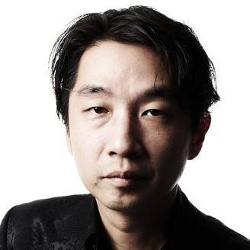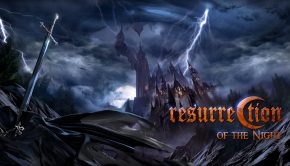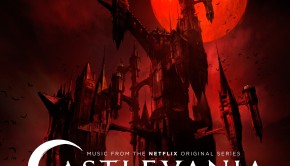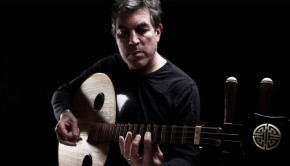Akira Yamaoka Profile
 |
Also Known As: 山岡 晃 (やまおかあきら) / A. Yamaoka / Chang Ma / MACHINE HEAD |
| Date of Birth: February 6, 1968 (Niigata) |
|
| Residence: Tokyo |
|
| Game Works: Silent Hill, Shadows of the Damned, Bemani |
|
| Official Site: Grasshopper Manufacture |
History
| Organisation | Type | Tenure | Role |
| Konami | Game Developer | 1993 – 2009 | Composer, Sound Designer |
| Konami | Game Developer | 1999 – 2009 | Sound Director |
| Konami | Game Developer | 2003 – 2006 | Producer |
| GE-ON-DAN | Artist Collective | 2009 – 2011 | Member |
| Grasshopper Manufacture | Game Developer | 2010 – | Composer, Sound Director |
| Grasshopper Manufacture | Game Developer | 2011 – | Chief Creative Officer |
| The Silent Hill Band | Music Group | 2012 – | Co-Founder, Composer, Arranger, Guitars |
Biography
Akira Yamaoka, currently serving as the chief creative officer and sound director of Grasshopper Manufacture, is best known for his work on the Silent Hill series. Born on February 6, 1968 in Niigata, Yamaoka was captivated from an early age by a myriad of popular musicians he found persuasive and original. His earliest memory was being blown away by Visage’s “Moon Over Moscow” on the radio and, during his teenage years, he also enjoyed the music of Ultravox, Depeche Mode, Metallica, and Vangelis, among others. Given this background, it is unsurprising that he decided to start playing guitars and keyboards. At high school, he learned about sequencing after buying a computer and also started composing music after forming a punk rock band. Though Yamaoka was also an avid gamer, he did not listen to game music for personal enjoyment, believing it was a shallow form of expression. The artist didn’t initially plan on becoming a musician, going on to study product design and interior at the Tokyo Art College, but developed a fascination in the connections between art and music through these studies. This connection eventually led him to compose video games.
After graduation, Yamaoka pursued a career as a freelancer composer during his early 20s. While his musical interests were wide-reaching, he had the most success in the video game field and ended up co-composing 1991’s Smart Ball (aka Jerry Boy) on behalf of Game Freak. This project made him appreciate the technical challenges of video game scoring, since he needed to compose and program music using a trial-and-error approach to accommodate the very limited memory of the Super Nintendo. Seeking stable employment, he went on to join the sound team of Konami’s Tokyo branch in 1993. The artist originally composed music for two simultaneously developed mascot-focused platformers, the Genesis’ Sparkster: Rocket Knight Adventures 2 alongside Michiru Yamane and the Super Nintendo’s Sparkster as part of an ensemble team. His compositions were much lighter than the majority of his subsequent works, but they certainly matched the tone of the games and impressed his supervisors. The artist was also one of the sound creators involved in the production of Contra: Hard Corps. Having long held a love for the Contra franchise, he was happy to be able to contribute to it on some level.
Yamaoka was eager to embrace the opportunities provided by the CD-based consoles released by Sega and Sony in the mid-90s. As a result, he felt privileged to work on the Sega CD remake of Snatcher. Blending redbook audio recordings with PCM files, the enhanced soundtrack helped to bring Hideo Kojima’s text adventure to life. Though Yamaoka’s role was as a sound designer, he found this responsibility just as fascinating as his other work — believing that his capabilities should extend beyond just composition and arrangement to creating sound itself. Yamaoka returned for the Saturn and PlayStation versions of the game, where he was credited as a guest composer. In a further technical role, he was responsible for the entire sound effects collection featured on the PlayStation RPG Vandal Hearts in 1996. He also handled the sound editing for the retro compilation Gradius Deluxe Pack, before creating the new music and sound design featured in the cinematic opening and title screens of the Salamander Deluxe Pack and Gradius III & IV. The artist also occasionally contributed to Konami’s CD releases; writing two tracks for the Twinbee Paradise 2 song collection, he mixed strong vocal parts with his own guitar performances.
Yamaoka’s strong sense of individuality shone when he was appointed to handle the PlayStation version of the arcade game Road Rage (aka Speed King) in 1996. While he was initially assigned to port the game’s original music, he felt disappointed with its sleazy sound and elected to create an all-new score. The final result was a dynamic, cyber-flavoured soundtrack that incorporated a variety of electronic styles considered modern for the time. During the same year, he also led the adventurous soundtrack for Goemon: Space Pirate Akoging! and co-composed Konami’s first 3D fighting game, Lightning Legend. He went on to pen wildly different scores for two other fighting titles, filling Poy Poy 2 (aka Poyter’s Point 2) with frivolous pop-flavoured tunes and contributing harder rock and techno fusions for Kensei: Sacred Fight. Also responsible for scoring International Superstar Soccer Pro ’97, he offered a cutting-edge club sound featuring breakbeats influenced by The Prodigy. He further shared his progressive vision for sports game soundtracks on ESPN MLS GameNight and NBA in the Zone ’98. At special request, he also handled the drum programming for Michiru Yamane’s Castlevania: Symphony of the Night and the sample manipulation for the independent multi-composer concept album 2197.
In 1999, Yamaoka created the sound for the survival horror title Silent Hill. He voluntereed for the role with the belief that he was the only Konami employee capable of composing music compatible with the game’s concept. Wanting to make the differentiation between other scores in the genre, he opted to compose mostly using industrial ambience and experimental noise, despite never listening to the genres otherwise. He carefully created the score early in the game’s production to be representative of its cold and rusty environments, using descriptions of scenes to inspire him. The score’s main purpose was to be psychologically disturbing, however, and this was principally why Yamaoka opted for a relentless unmelodic sound. His other roles included meticulously creating numerous sound effects for the game, engineering and programming the sound for the PlayStation, and mixing its soundtrack release after finalising the track selection. Indeed, in a project that would normally require six to eight people, Yamaoka competently dealt with all aspects (except the ending theme song) alone. While the soundtrack did not appeal to all on a stand-alone basis, the sound came together excellently with the other aspects of the game and was a landmark achievement for video game audio.
Having finally received widespread recognition through his work on Silent Hill, Yamaoka was invited to contribute to Konami’s Bemani line of music games. Initially responsible for two remixes featured in GuitarFreaks 2nd Mix Append, he went on to produce four popular tracks on beatmania IIDX 4th Style; ranging from the trance anthem “Love’s Will”, to the gabba techno of “250bpm”, to the cyber rock stylings of “Diamond Jealousy”, Yamaoka amazed producers will his versatility. He returned by popular request for the follow-up, writing the uplifting songs “in my eyes” and “RISLIM” with vocalist riewo. Over an extended period, Yamaoka also worked on 2001’s Silent Hill 2, a more interactive sequel released for the PlayStation 2. The score score was psychologically affecting like its predecessor, but more emotionally expressive and stylistically rich. The Japanese and European soundtrack releases, while only featuring a specially selected collection of the game’s themes, were major commercial successes and rock tracks like “Theme of Laura” and “Promise” gained iconic status. In order to enhance the interactivity of the title, Yamaoka worked especially hard making a large number of realistic sound effects, creating 200 footstep sounds alone.
Having gained a large fanbase following the completion of Silent Hill 2, Yamaoka requested he compose the Arcade shooter Contra: Shattered Soldier (aka Shin Contra). Joined by Sota Fujimori, he emphasised the intense feel of the gameplay with electric guitar-driven stage and boss themes — each as aggressively conceived, yet meticulously rendered, as the next. He also returned to the 7th, 8th, and 9th iterations of the beatmania IIDX series, in each case combining new experiments with careful consideration of the rhythm-based gameplay; tracks such as “Love Me Do”, “Lion Lover”, and “bit mania” proved especially enduring. On 2003’s Silent Hill 3, his responsibilities increased again when he took on the role of producer. As a consequence, Yamaoka was responsible for the game’s concept and implementation in a massively time-consuming and tiring role. He focused on increasing the element of interactivity that he considered so integral in the distinction between video games and movies. The score was largely continuous with Silent Hill 2’s, but Yamaoka made some innovations; he produced alternative rock vocal tracks sung by Mary Elizabeth McGlynn and Joe Romersa and collaborated with Swedish band Interlace to produce the bonus track featured on the soundtrack release.
Yamaoka returned as producer and sound director for 2004’s Silent Hill 4: The Room. On this project, he and director Masashi Tsuboyama created a psychological focus and claustrophobic atmosphere that reflected the first-person perspective and, as inspired by Ryu Murakami’s book Coin Locker Babies, the concept of ’The Room’. The soundtrack mixed rhythmically compelling ambience with more vocal themes by McGlynn and Romersa. The Japanese soundtrack release from Konami once again proved to be a best-seller. For the first time, there was also a limited edition American soundtrack featuring remixes and original compositions not available on the Japanese and European releases. Yamaoka also produced two further musical tie-ins: Inescapable Rain in Yoshiwara, a dramatic story narrated by Teisui Ichiryusai featuring Yamaoka’s background music, and Silent Hill 4 Robbie Tracks, a mini-album featuring experimental remixes inspired by European electronica artists. Reflecting the global influence of the series’ music, Yamaoka’s music was performed at the Symphonic Game Music Concerts that occurred in Germany during 2005 and 2006. Around the same time, Yamaoka also composed two guitar-based tracks for the women’s wrestling game Rumble Roses and took a slightly larger role on its sequel.
Between his ongoing roles on the Silent Hill and beatmania IIDX franchises, Yamaoka also marked his debut on another franchise with 2004’s pop’n music 12: Iroha. Yamaoka went on to make annual offerings to the series at request of sound director wac; tracks such as “Ryuusei Honey”, “April Fool’s Song”, “popdod”, and “BI-BUN-SEKI-BUn” particularly appealed to players with their vibrant beats and amusing vocal performances. Between 2004 and 2006, he also offered a series of electronic remixes for the Dance Dance Revolution series — spanning interpretations of his own compositions from Silent Hill and beatmania IIDX, to covers of the seminal hits by Gloria Gaynor and Britney Spears. In early 2006, Yamaoka celebrated his club music sound with his first solo album, iFUTURELIST. While a few tracks were related to Silent Hill, the overall album was filled with upbeat, electrifying vocal themes. The album included a number of extended and remixed versions of Bemani classics along with an eclectic range of new compositions — among them, the dark entrancing soundscapes of “Mad Season”, the gorgeous string-supported ballad “Maria”, and, featuring his own vocals, the 80s-influenced rock song “iFUTURELIST”. Though not all warmed to the release, it provided a fascinating insight into his individual musicality.
In 2006, Yamaoka served as an executive producer of the largely successful film adaptation Silent Hill. He frequently shared his opinions with director Christophe Gans during the production and also oversaw the implementation of the soundtrack. Though he was unable to compose any new tracks for the film, he was delighted that over 30 of his compositions from the game series were incorporated into the movie — some directly reused, others arranged by Jeff Danna to reflect the context. The perfectionistic composer was largely satisfied with how the pieces were integrated. The same year, Yamaoka performed Silent Hill’s music live at the Chicago premiere of PLAY! A Video Game Symphony; accompanied by a full orchestra, Yamaoka stunned audiences with his electric guitar performance of “Theme of Laura” and returned to the tour for several further performances. In 2007, Yamaoka also received a glorious reception when he performed live sets at two major Japanese events. He took a central role in the beatnation Summit, featuring performances from beatmania’s most influential artists, and also duetted with Metal Gear Solid’s Norihiko Hibino at the Extra: Hyper Game Music Event.
Yamaoka returned as the composer for the PSP prequel Silent Hill: Origins, despite the project being outsourced to a West developer. The artist combined influences from all preceding series’ scores to offer a powerful in-game accompaniment and cohesive stand-alone experience. By contrast, he shifted the focus of 2008’s Silent Hill: Homecoming away from rock stylings in favour of ambient and oppressive timbres. The title nevertheless featured several vocal themes performed by Mary Elizabeth McGlynn, including direct portrayals of central characters Alex and Elle. Yamaoka concluded his time on the game series the following year on the remake Silent Hill: Shattered Memories. The soundtrack mixed references to the main theme and noise music of the original game — as well as an experimental cover of “Always on my Mind” — with theme songs and trip-hop elements more akin to the series’ more scores. Between these productions, Yamaoka also penned remixes to Otomedius-G and made further contributions to Bemani series. His final contributions to Bemani were two collaboration songs with Chiaki Kyan and DJ Yoshitaka, the uplifting pop song “Clay Dance” for pop’n music 18, and, fittingly, a remix of “iFUTURELIST” for Dance Dance Revolution X2. His last credited work for Konami was the album Composers.
Akira Yamaoka left Konami in 2009 to pursue new projects for video games and beyond. Shortly after announcing his departure, he was scouted for a position at Grasshopper Manufacture by Goichi Suda (aka SUDA51) that proved too tempting to resist. After all, Yamaoka had long admired the company’s games, feeling that they pursue original, interesting approaches in the otherwise stagnant Japanese games industry. Initially penning three tracks for No More Heroes 2: Desperate Struggle, he went on to score the entirety of 2011’s Shadows of the Damned, a stylish and humorous horror game from SUDA51 and Shinji Mikami. Largely continuous with his Silent Hill work, the soundtrack combined elements of trip-hop, ambient, and industrial styles with inspired rhythms and nuanced timbres. The artist also reunited with lyricist Joe Romersa and vocalist Mary Elizabeth McGlynn for three of the vocal themes, between collaborating with punk band The Damned for the theme song. The music was celebrated with a sell-out soundtrack release and several live performances. His experiences on Bemani franchises proved useful as a sound director Rebuild of Evangelion: Sound Impact, since he was experienced with the technical and creative aspects of scoring for rhythm games; the soundtrack blended several original compositions with contemporary remixes of Shiro Sagisu’s anime scores.
Yamaoka has also participated in a range of non-game projects in recent years. The artist made his debut on television as the music supervisor for TV Asahi’s detective show Meitantei no Okite; in each episode, he reflecting the detective show’s premise with a mixture of mysterious and comedic tracks spanning a range of styles. Following the Tohoku earthquake, Yamaoka conceived and produced the highly successful charity album Play For Japan; uniting eighteen of the biggest names in the Western and Japanese games industry, the album reflected the individuality of each contributor while providing an overriding hopeful message. Yamaoka raised further relief funds by releasing a sequel album and also creating the Otomodachi EP through Grasshopper Manufacture. The artist was also selected to create the original score for Sdatcher, a radio-style drama inspired by Hideo Kojima’s Snatcher and scripted by Goichi Sada. The score blended aspects of the composer’s signature style with homages to the 80s films that inspired the original game. He has since handled the music and sound design fro the 3D sound drama Shitsuji Yuu Gitan. In wider roles, he has also penned special arrangements for the DeathSmiles Arrange Album and The Scythian Steppes.
Despite departing Konami, it is clear that the Silent Hill series is very important to Yamaoka. The artist was invited to return to the soundtrack for 2012’s Silent Hill: Revelation 3D and happily obliged; while the soundtrack was largely comprised of Jeff Dana’s arrangements of the game scores, Yamaoka penned three new cinematically inclined tracks for the release. Throughout the project, he found it satisfying and nostalgic to revisit the work he had done on the game series. In the past year, he has formed The Silent Hill Band to perform the series’ music and other tracks live to audiences acros sthe world. Featuring himself on guitars, Mary Elizabeth McGlynn on vocals, Troy Baker on bass guitar, and Joe Romersa on drums, the rock band made their debut performances at Arizona’s Saboten Con and Querétaro’s V-CON during 2012. During the latter event, Yamaoka released the band’s debut single Revolución. The artist has also recently performed the series’ music at Spain’s PlayFest 2012 and several of Video Games Live’s shows. However, he has had no direct involvement in the series’ latest games, replaced by Daniel Licht, and wasn’t even credited on the Silent Hill Sounds Box.
While Yamaoka initially joined Grasshopper Manufacture as the sound director, he also intended to use his “total sum of experience” — including producing the Silent Hill series — to develop new titles as well. By late 2011, he was promoted to Chief Creative Officer at the developer. In this role, he heads all development at the 60-person studio and oversees every project they work on. Yamaoka continues to serve as the sound director for the majority of the company’s projects as well. He went reflected the bizarre, satirical scenario of Lollipop Chainsaw with a suitably eclectic soundtrack — mixing pop and metal stylings, licensed and original tracks at a whim. He has also led the soundtracks for Sine Mora and Black Knight Sword, both 2D titles that blend classic and modern influences; whereas the former was filled with 70s-influenced electronic soundscapes, the latter featured an off-the-wall assortment of styles. The artist clearly enjoys life at Grasshopper Manufacture and appreciates how creativity, teamwork, and fun are all top priorities. Having done an impressive job balancing a multitude of responsibilities since leaving Konami, Yamaoka hopes to one day design a game of his own. He is currently working on Killer Is Dead.
References:
– Various Game & Album Credits
– VGMdb Discography
– Liner Notes Translations
– Official Site (English)
– Official Blog (Japanese, Discontinued)
– Interview with RocketBaby (English, Archived, October 2001)
– Interview with Spelmusik (English, July 2002)
– Interview with Kilizo (English, September 2004)
– Interview with Spelmusik (English, June 2006)
– Interview with Music4Games (English, October 2007)
– Interview with Gamasutra (English, December 2007)
– Interview with Gamasutra (English, April 2010)
– Interview with Gamasutra (English, October 2010)
– Interview with 1UP (English, October 2010)
– Interview with Music Japan Plus (English, July 2012)
© Biography by Chris Greening (September 2007). Special thanks to Ben Schweitzer. Last updated on March 13, 2013. Do not republish without formal permission.
Posted on March 13, 2013 by Chris Greening. Last modified on March 21, 2014.














